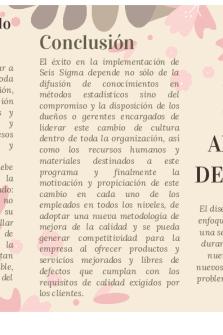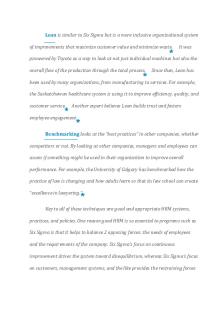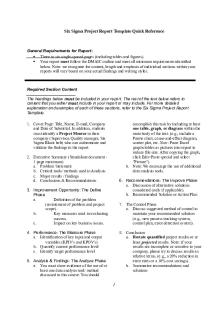SIX Sigma PDF

| Title | SIX Sigma |
|---|---|
| Course | Operations Management |
| Institution | SVKM's NMIMS |
| Pages | 4 |
| File Size | 146.3 KB |
| File Type | |
| Total Downloads | 87 |
| Total Views | 175 |
Summary
Six sigma document...
Description
SIX SIGMA MUDA- NON-VALUE ADDING WORK MURI- OVERBURDEN MURA- UNEVENNESS DMAIC DEFINE PHASE: VOC CTQ Project charter map the process 1. Analyse VOC with help of Affinity diagram and Kano Model Affinity diagram: Organize VOC into broad categories like availability, easy process, product etc.. Kano Model: must be needs, more is better and delighters 2. CTQ: Build forms, quick surveys and validate CTQ with customers 3. Project charter: should include problem statement, SMART Goals, project scope, Project plan 4. Map the process: use SIPOC(Supplier-Input-Process-Output-Customer), Sub Process Map and value stream mapping. Sub Process Map: Focus on why the problem is occurring. Clarify the boundaries brainstorm sessions use process flow charts which are upside down with yes and no implications. Also use cross-functional maps MEASURE PHASE Type of data: discrete, continuous Histograms (right skewed, left skewed, uniform), used mean, mode, median, range, variance, SD Normal distribution, Box Plot (to identify outliers) Validating the measurement system by using: Variable gage R&R: Attribute agreement analysis Process capability: determine whether the process is capable enough to meet customer requirements or not. A process is said to be capable when the ±3σpoints of the distribution of individual measurements are contained well within the specification limits. Rolled Throughput Yield: RTY is the probability of obtaining a unit with zero defects.
RTY can be used ...: To identify opportunities for improvement. To characterize the process steps, unveiling the hidden factory. ANALYZE PHASE Why do a root cause analysis? Use the process data to understand the problem and identify the vital few root causes in order to reduce variation that the customer experiences. Cause and Effect diagram/ fishbone A visual tool used by an improvement team to brainstorm and logically organize possible causes for a specific problem or effect. Pareto Analysis A Pareto chart is a bar chart that graphically ranks defects from largest to smallest, which can help prioritize quality problems and focus improvement efforts on areas where the largest gains can be made. Map the value stream Value stream map is a sequence of steps taken to create product / service to the end customer. Value stream mapping identifies the Value Added (VA) / NonValue Added (NVA) / Value Enablers (VE) steps in a process and quantifies time spent on each step Takt Time (TT): Takt time is the rate at which one needs to complete the production process in order to meet customer demand. TT=Net Operating Time/Customer Demand The seven wastes are TIMWOODS Transportation, Inventory, Motion, Waiting, Overproduction, Overprocessing, Defects AND ‘Skills’ of workers.
Control impact matrix Matrix with high low control and impact. prioritize the root causes obtained in our root cause analysis using Control Impact Matrix Using the control/impact matrix, examine each X in light of two questions: What is the impact of this X on our process?
Is x in control of our team or not
We use hypothesis testing in the Analyze phase of our DMAIC journey to verify that a suspected cause(X) truly impacts the CTQ(Y). Generally, if P-Value...
Similar Free PDFs

SIX Sigma
- 4 Pages

Aplicacion SIX Sigma triptico
- 2 Pages

Calidad total six Sigma
- 19 Pages

Six sigma HR
- 2 Pages

Metode Penelitian Six Sigma
- 1 Pages

SIx sigma el TPS
- 15 Pages

Makalah Six Sigma
- 20 Pages

Metodología SIX Sigma Y DPMO
- 14 Pages

Six Sigma Project Report Template
- 12 Pages
Popular Institutions
- Tinajero National High School - Annex
- Politeknik Caltex Riau
- Yokohama City University
- SGT University
- University of Al-Qadisiyah
- Divine Word College of Vigan
- Techniek College Rotterdam
- Universidade de Santiago
- Universiti Teknologi MARA Cawangan Johor Kampus Pasir Gudang
- Poltekkes Kemenkes Yogyakarta
- Baguio City National High School
- Colegio san marcos
- preparatoria uno
- Centro de Bachillerato Tecnológico Industrial y de Servicios No. 107
- Dalian Maritime University
- Quang Trung Secondary School
- Colegio Tecnológico en Informática
- Corporación Regional de Educación Superior
- Grupo CEDVA
- Dar Al Uloom University
- Centro de Estudios Preuniversitarios de la Universidad Nacional de Ingeniería
- 上智大学
- Aakash International School, Nuna Majara
- San Felipe Neri Catholic School
- Kang Chiao International School - New Taipei City
- Misamis Occidental National High School
- Institución Educativa Escuela Normal Juan Ladrilleros
- Kolehiyo ng Pantukan
- Batanes State College
- Instituto Continental
- Sekolah Menengah Kejuruan Kesehatan Kaltara (Tarakan)
- Colegio de La Inmaculada Concepcion - Cebu






![[Michael L. George] Lean Six Sigma Combining Six(Book Fi org)](https://pdfedu.com/img/crop/172x258/z83g4ryognjp.jpg)